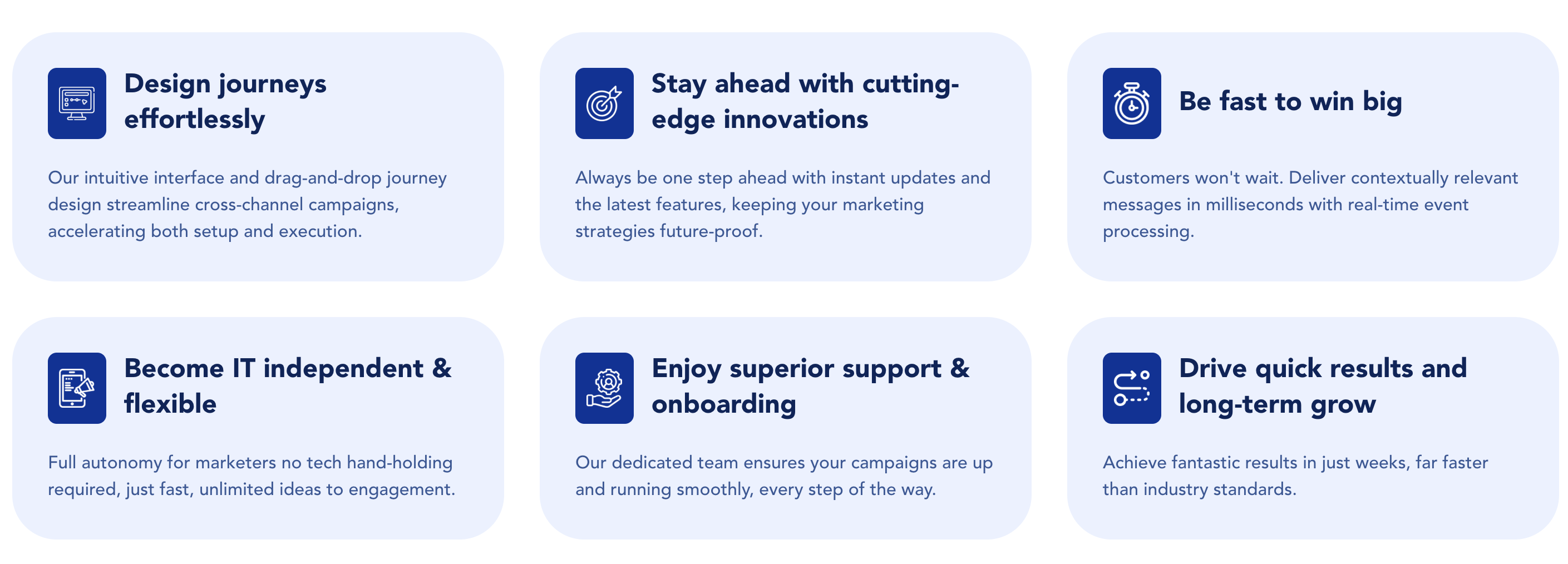-
1. Why Integration of Martech Tools Matters
- Consistency Across Channels
- Real‑Time & Data‑Driven Decisions
- Frictionless User Experience
- Lead Generation & Lead Nurturing
-
2. How to Integrate Martech Tools into a Mobile App
- 1. SDKs and APIs
- 2. Data Infrastructure
- 3. UI/UX Alignment
- 4. Cross‑Channel Coordination
-
3. Common Challenges in Integration
- 1. Data Silos
- 2. Latency Issues
- 3. Privacy and Compliance Concerns
- 4. Developer Dependencies
- 5. Overcomplexity
- 4. evamX: Seamlessly Integrating Martech Solutions into Mobile Apps
In today’s fast-paced digital landscape, a mobile app is more than just a product; it’s the heart of a brand’s customer relationship. But while apps are powerful tools for engaging users, many brands still struggle to fully leverage martech solutions within their mobile experience. Martech tools like personalized messaging, customer analytics, and real-time data optimization can unlock massive potential, but only if they’re integrated properly.
In this post, we’ll explore the importance of seamlessly integrating martech solutions into your mobile app, how to overcome common challenges, and the best practices for creating a connected and personalized customer experience that drives real business impact.

Why Integration of Martech Tools Matters
When it comes to martech, the goal isn’t just to collect data or launch marketing campaigns; it’s to create a seamless and consistent experience for users across every touchpoint. Integration is the key to making that happen.
Without a deep integration of martech tools into a mobile app, brands are likely dealing with fragmented user experiences that fail to deliver the real-time relevance customers demand. Imagine sending a personalized push notification based on a user’s in-app behavior, only to find that the app’s backend doesn’t have the right data, or that the campaign trigger doesn’t fire at the right moment. This disconnect creates friction, and worse, it risks losing customer trust.
Here’s why integration is absolutely essential:
1. Consistency Across Channels
Whether it’s in-app messages, emails, push notifications, or even ads, integrated martech systems ensure brand messaging and customer experiences are consistent everywhere. When these omnichannel tools work together seamlessly, users feel like they’re interacting with a unified brand, not disparate channels.
2. Real-Time & Data-Driven Decisions
The power of martech lies in the data it generates and the insights it provides. When data from an app is synchronized with a brand’s marketing technology, decisions can be made in real time, which empowers personalized and contextually relevant interactions that increase engagement and conversion rates.
3. Frictionless User Experience
When martech solutions are embedded directly into an app’s flow, users get the most relevant content at the most opportune moments. This smooth and intuitive experience is what keeps users coming back, whether they’re getting real-time recommendations, personalized offers, or just-in-time support.
4. Lead Generation & Lead Nurturing
Integration also plays a pivotal role in converting leads into customers. When martech tools are synced with an app, brands can gather valuable lead data directly from user interactions. Whether they’re signing up, browsing, or abandoning a cart, that customer data can then be used to nurture leads through tailored content, drip campaigns, and targeted offers.
How to Integrate Martech Tools into a Mobile App
Integrating martech into a mobile app isn’t just about adding a few extra tools, it’s about creating a unified ecosystem where data flows seamlessly and marketing efforts align with the user experience.
Here’s a breakdown of the core elements involved in the integration process:
1. SDKs and APIs
Software Development Kits (SDKs) and Application Programming Interfaces (APIs) act as the bridge that connects an app with external martech platforms. SDKs allow for easy integration of third-party tools directly into a mobile app, enabling functionalities like in-app messaging, personalized recommendations, push notifications, and more.
APIs, on the other hand, allow different systems to communicate with each other in real time, ensuring that the app, analytics platforms, and marketing tools are always working with the latest data. Together, these tools help brands plug in the right solutions without overhauling an app’s core structure.
2. Data Infrastructure
A robust data infrastructure ensures that user behavior and preferences are captured in real time and can be sent to marketing channels like email, social media, and advertising systems. By aligning an app’s data pipelines with these systems, brands enable personalized experiences and make sure that marketing efforts are always based on users’ most recent activity; whether it’s the last item viewed, a recent search, or even a potential churn signal.
3. UI/UX Alignment
Martech integrations should never disrupt the core user experience of an app. Instead, they should enhance it. For example, personalized product recommendations, dynamic content feeds, or targeted offers should feel like a natural part of the customer journey, not like an unrelated popup or banner. The more integrated these elements are with the app’s design and flow, the more likely users are to engage with them. A mobile app should feel like it's evolving in real time, anticipating user needs and preferences in a way that’s intuitive, not invasive.
4. Cross-Channel Coordination
Integration isn’t just about an app, it's about syncing a mobile experience with the wider martech landscape. Cross-channel coordination ensures that user interactions within the app seamlessly translate into relevant messaging across other channels, like email or SMS. If a user adds an item to the cart but doesn’t check out, a real-time push notification or follow-up email can nudge them to complete their purchase. Without integration, a brand's marketing tools would operate in silos, missing opportunities to engage users where they are most active.
To sum it up, integrating martech into a mobile app is about building a system where all the tech works in harmony to create a personalized and frictionless experience. However, integrating martech into a mobile app, while it can provide significant benefits, is not without its challenges.
Common Challenges in Integration
Many brands face hurdles when trying to synchronize tools, manage data, and maintain a smooth user experience. Understanding these common obstacles and knowing how to tackle them can help ensure a brand’s integration efforts lead to success rather than frustration.
Here are some of the most frequent challenges brands will encounter and how to overcome them:
1. Data Silos
One of the biggest challenges is ensuring that data flows smoothly between a brand's app and the martech platforms it's using. Without proper integration, data can end up siloed in separate systems, making it difficult to get a unified view of user behavior or launch personalized campaigns.
SOLUTION: Having a centralized data warehouse or customer data platform (CDP) that consolidates user information in real-time can make syncing much easier and ensure data is always up-to-date and accessible.
2. Latency Issues
In the world of real-time personalization, timing is everything. If a brand's integrations aren’t optimized for speed, it can lead to delays in triggering messages, offers, or content updates. This can be especially detrimental if a brand is trying to act on time-sensitive data, like cart abandonment or an in-app action.
SOLUTION: Platforms with low-latency integrations and automatic data syncs will help ensure that marketing actions are timely and relevant, giving users the experience they expect.
3. Privacy and Compliance Concerns
With GDPR, CCPA, and other data privacy regulations in place, integrating martech tools that handle sensitive customer data comes with serious responsibilities. If data is mismanaged or shared inappropriately across systems, brands could face hefty fines or reputational damage.
SOLUTION: Prioritizing martech solutions that are compliant with privacy laws and regulations is key. Adopting an integration strategy that includes strong encryption, data anonymization, and user consent mechanisms, as well as regular audits of data processes are essential to ensure compliance.
4. Developer Dependencies
Marketers often find themselves waiting for engineering teams to implement or modify integrations, slowing down the speed at which they can roll out campaigns or adjust experiences. This gap can lead to missed opportunities, especially in a fast-moving digital environment.
SOLUTION: Martech platforms that offer no-code or low-code tools for easy integration and campaign management enable marketing teams to take the reins on adjustments, giving them more flexibility to iterate quickly. Collaboration between marketing and development teams is also key. Having clear communication channels and shared goals will ensure smoother workflows.
5. Overcomplexity
It’s tempting to integrate every shiny new martech solution out there, but more isn’t always better. Having too many disconnected tools can lead to cluttered workflows and confusion, making it hard to track performance or maintain consistency.
SOLUTION: Be strategic about the tools you choose and focus on building a martech stack that aligns with your core business objectives. Look for platforms that offer multiple functionalities, such as analytics, messaging, and automation in one package, so you can reduce the complexity of your integrations and keep your tech stack streamlined.
evamX: Seamlessly Integrating Martech Solutions into Mobile Apps
At evamX, we take the complexity out of martech integration, making it easy for marketing teams to create impactful and personalized experiences.
evamX reduces reliance on IT teams, allowing marketing teams to quickly integrate your existing martech stack, reducing setup time and enabling rapid deployment.
With real-time data syncing and omnichannel orchestration, you can deliver consistent, personalized messaging across various channels, ensuring that every user interaction feels seamless and relevant.
evamX also prioritizes data privacy and compliance, so you can confidently manage user data while adhering to regulations like GDPR and CCPA.
By eliminating the technical hurdles and offering flexible and scalable solutions, evamX helps you create a unified marketing ecosystem that drives customer engagement and retention.

Are you ready to unlock the full potential of your mobile app? Contact Us








